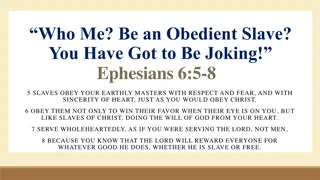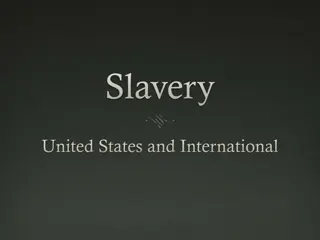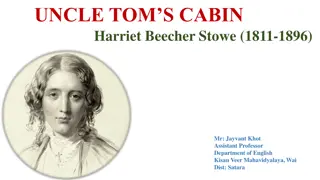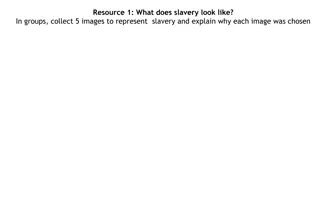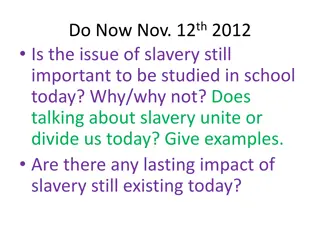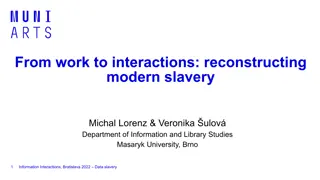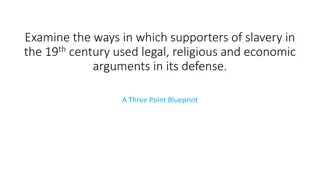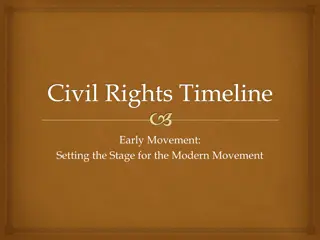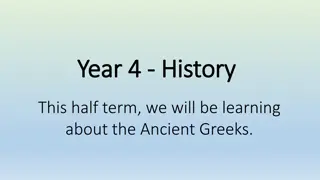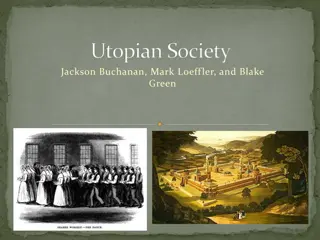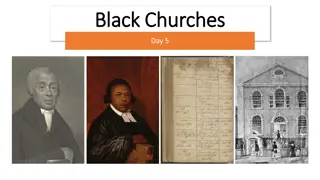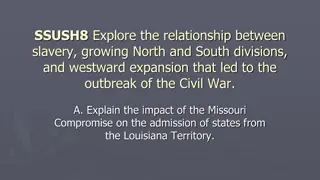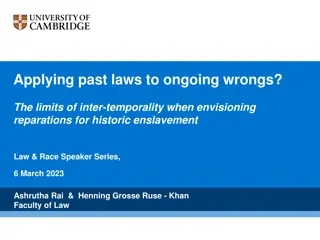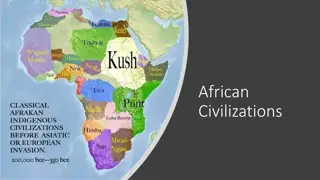Understanding the History and Impact of Slavery in Ancient Societies
Delve into the origins, forms, and implications of slavery in ancient societies, exploring diverse aspects such as treatment of slaves, legal frameworks, and philosophical perspectives. Discover how slavery shaped social structures and human perceptions throughout history.
Download Presentation

Please find below an Image/Link to download the presentation.
The content on the website is provided AS IS for your information and personal use only. It may not be sold, licensed, or shared on other websites without obtaining consent from the author. Download presentation by click this link. If you encounter any issues during the download, it is possible that the publisher has removed the file from their server.
E N D
Presentation Transcript
Slavery Kunta Kinte Dr. Rick Griffith Jordan Evangelical Theological Seminary BibleStudyDownloads.org
Presentation a Introduction and definition of slavery b Slaves in ancient societies c Treatment of slaves e What does slavery reveal about people? d What the Mosaic law taught on slavery e Mosaic vs. Pagan slavery laws f Slavery during Roman Empire g Paul's teaching on slavery h Conclusion
Slavery Aristotle "the slave is a living tool and the tool is a lifeless slave"
Introduction and definition Origins of Slavery: How slavery originated cannot be precisely ascertained Earliest evidence of slavery stemmed back to 3000 BC, from Sumerian civilization in Southern Mesopotamia (modern Iraq)
Introduction and definition Sources of Slavery 1. POW 2. Debt 3. Born to debtors 4. Capture Joseph was captured and sold into slavery for 20 pieces of silver 5. Voluntary servitude
Introduction and definition Forms of Slavery Different forms of slavery Lowest on the social ladder House slaves (e.g., Hagar the Egyptian in Abraham's household) Temple slaves Work slaves Slaves to Kings some scarred City slaves Artisans
Introduction and definition Sumerian Definition Sumerian word for slave means "person from a foreign land" Captives made into "people of restricted freedom" Captives seized in battle, not local inhabitants Used to construct canals, plant & harvest crops
Image4 Introduction and definition Other definitions: State of person purchased by another A system of forced labor Control of a person against his or her will Slave being examined Securing work from one under harsh conditions for little or no pay
Photo courtesy of Anne Raia Introduction and definition Slavery in Ancient Rome Roman law: slave is a thing, a chattel, a mortal object
Introduction and definition Roman law vs. Greek Law: Roman Law Slaves no different from livestock Piece of property Denied majority of fundamental rights not allowed to marry or form families Stone carving of two slaves Greek Law Slaves had some freedoms To be own representative Go where he desires to go Do what he desires to do
Image8 Introduction and definition Important terms: Peculium allowance Manumission slave given freedom and released from all of his duties 3 common methods used by Roman master to manumit his slaves -Census -Vindicta -Testamentum Woman with her slaves
Slaves in Ancient Societies Major population group in ancient social strata All ancient civilizations had slavery Slave trade was common Joseph was sold to slavery in Egypt
Slaves in Ancient Societies In Babylon the social strata was: 1. King 2. Nobles awilu 3. Free Citizens of low estate-mushkenu 4. Slave-wardu - Most slaves were POWs - Free citizens could be sold into slavery due to offences or debts - Almost impossible for slaves to become free
Slaves in Ancient Societies Population of the entire defeated land was commonly taken into slavery: During reign of Thutmose III slaves were part of the tributes paid by the defeated foe: " in that year 295 male and female slaves, 68 horses, 3 gold dishes, 3 silver dishes" (Report from the 42nd (?) year of the reign of Thutmose III) Joshua subjected the Gibeonites to slavery: "you shall never cease being slaves, both hewers of wood and drawers of water for the house of my God" (Joshua 9:23)
Slaves in Ancient Societies Ancient Slavery of Women The sketch is from a wall relief depicting the Assyrians being taken away into captivity. There was no hope for these women and they were usually forced to serve as prostitutes. The ancient Assyrians were among the most ruthless of all ancient warriors. This was the fate of the women of the rebellious Israelites of the Northern Kingdom.
Slaves in Ancient Societies Slavery was readily legitimized Essential for functioning of ancient civilizations Ancient civilization were agricultural, & labor intensive Most ancient cities were built by slaves Egyptian Pyramids might have been a longstanding monument of such practices
Slaves in Ancient Societies Common Practice in Ancient Near East (ANE) Reflected low morality of ANE civilization Little value on human life due to seeing humans as slaves created for the gods Slaves were property, and therefore mostly treated like animals
Treatment of Slaves Treatment largely depended on the character of the master: Early Egypt Slaves were sacrificed and buried with the dead king to serve him in the nether world
Treatment of Slaves Work slaves in mines worked long hours on meager rations - they were "worked to death as one wears out a machine"
Treatment of Slaves As property, slaves could be sold in wills: Title of Property made by Uab In it slaves were property given to his wife. The wife was also free to give away children born to him by his slaves.
Treatment of Slaves Some minorities with exceptional abilities were treated better. Examples: 1. Daniel 2. Joseph Court Servant probably one that serves the king
What does slavery reveal about people ? Slavery is a product of the fall of man and has existed since the Fall Slavery was a means of survival Slavery as an alternative to killing is more humanitarian Rather than killing enemies, they were sometimes made as slaves (Deut. 20:11) Gibeonites preferred slavery over death (Josh. 9:3-27) Joseph was sold as a slave instead of being put to death (Gen. 37:12-38)
What does slavery reveal about people? Warm affection between master and slave could exist: Punishment for attempted rape of a master's wife was death. However, Potiphar only imprisoned Joseph due to their closeness (Gen. 39:4-6, 19-20) Canaanites started as slaves to Israel but ended up intermarrying them and causing them to worship Baal (Judg. 1:27 3:6) Jewish slaves could choose to stay with their master rather than be freed after 6 years (Exod. 21:6)
What does the Mosaic Law teach about slavery? When God gave the Law to Moses, slavery was part of the world, and so the Law of God recognized slavery Types of Slavery Laws: 1. Acquisition of Slaves 2. Manumission 3. Religious rights 4. Civil rights 5. Marriages
What does the Mosaic Law teach about slavery? 1. Laws on Acquisition of Slaves Only foreign slaves could be made permanent slaves. Hebrew slaves were freed after 6 years or the year of Jubilee. War captives could be made slaves (Deut. 20:10-11) As restitution for theft (Exod. 22:1-3) By default on debts (Deut. 15:1- 2)
What does the Mosaic Law teach about slavery? 1. Laws on Acquisition of Slaves By purchase (Lev 25:44-46) Foreigners could be bought and sold as slaves, and considered as property No kidnapping of free-born person to sell as a slave was allowed (Exod. 21:16; Deut. 24:7) Prices of slaves varied widely, according to age, sex and number of years till Jubilee (Lev. 25:47-53) By Birth (Exod. 21:4; Lev. 25:54)
What does the Mosaic Law teach about slavery? 2. Manumission Law Exod. 21:1-11; Lev. 25:39-55; Deut. 15:12-18 This law helped avoid the risk of having a big population of slaves during an economic crisis Hebrew slaves would be freed after serving 6 years (Exod. 21:2) Slaves with a wife given by master must go alone Slaves wanting to stay permanently may do so, but they would have their ears pierced Freed slaves released with liberal pay (Deut. 15:12-15)
What does the Mosaic Law teach about slavery? 2. Manumission Law Runaway slaves were to go free, as the return of a fugitive was forbidden (Deut. 23:15-16) In the year of Jubilee, all Hebrew slaves were made free, in connection with the restoration of property and land (Lev. 25:39-40)
What does the Mosaic Law teach about slavery? 3. Law on Religious Rights Slaves were considered part of the owner's family and shared in the family's religious life Slaves were granted Sabbath rest (Exod. 20:10; 23:12) Slaves were to be circumcised and partake in feasts (Exod. 12:43-45)
What does the Mosaic Law teach about slavery? 4. Laws on Civil rights Masters would be punished if they killed their slaves (Exod. 21:20) Slaves were set free if they were maimed by their master (Exod. 21:26-27)
What does the Mosaic Law teach about slavery? 5. Laws on Slave Marriages Single slaves could be given wives by their master (Exod. 21:2-4) Such wives were usually foreigners Wives given by a master were permanent slaves and not released after six years
Comparing Mosaic Law and Pagan Laws Comparing Mosaic Laws and Pagan Laws 1. Term of service before release Mosaic Law (Deut 15:12-14) If a fellow Hebrew, a man or a woman, sells himself to you and serves you six years, in the seventh year you must let him go free. And when you release him, do not send him away empty-handed. Supply him liberally from your flock, your threshing floor and your winepress. Give to him as the LORD your God has blessed you. Law of Hammurapi [ 117] If a liability has become due against a man and he has (Bab. Ana kaspim) sold his wife and his son or his daughter or bound them, or each of them, or himself (Bab. It-ta-an-di-in) over into servitude (Bab, ana kissatim), for 3 years they shall do work in the house of him who has bought them or taken them in servitude; in the fourth year their release shall be established. 117
Comparing Mosaic Law and Pagan Laws Comparing Mosaic Laws and Pagan Laws 2. Marriage of Slaves Law of Ur-Nammu or Shulgi If a male slave marries a female slave, his beloved, and that male slave later is given his freedom, she/he will not be evicted from (lit. leave) the house. If a male slave marries a native woman, she/he shall place one male child in the service of his master; any other child of the native woman will not be owned by the master, nor will be pressed into slavery Mosaic Law (Ex 21:2-4) "If you buy a Hebrew servant, he is to serve you for six years. But in the seventh year, he shall go free, without paying anything. If he comes alone, he is to go free alone; but if he has a wife when he comes, she is to go with him. If his master gives him a wife and she bears him sons or daughters, the woman and her children shall belong to her master, and only the man shall go free.
Comparing Mosaic Law and Pagan Laws Comparing Mosaic Laws and Pagan Laws 3. Violation of slave woman Law of Ur-Nammu or Shulgi If a man acts in violation of the rights of another and deflowers the virgin slave woman of a man, he shall weigh and deliver five shekels of silver Law of Dadusha of Eshnunna If a man should deflower the slave woman of another man, he shall weigh and deliver twenty shekels of silver, but the slave woman remains the property of her master Mosaic Law (Lev 19:20) 'If a man sleeps with a woman who is a slave girl promised to another man but who has not been ransomed or given her freedom, there must be due punishment. Yet they are not to be put to death, because she had not been freed.
Comparing Mosaic Law and Pagan Laws Comparing Mosaic Laws and Pagan Laws 4. Action for runaway slaves Law of Ur-Nammu or Shulgi If [a slave or (?)] a slave woman ventures beyond the borders of his or her city and a man returns him or her, the slave's master shall weigh and deliver shekels of silver to the man who returned the slave Mosaic Law (Deut 23:15- 16) If a slave has taken refuge with you, do not hand him over to his master. Let him live among you wherever he likes and in whatever town he chooses. Do not oppress him.
Comparing Mosaic Law and Pagan Laws Comparing Mosaic Laws and Pagan Laws 4. Action for runaway slaves Law of Lipit-Ishtar If a man's female slave or male slave flees within a city, and it is confirmed that the slave dwelled in a man's house for one month, the one who harbored the fugitive shall give slave for slave. If he has no slave, he shall weigh and deliver fifteen shekels of silver. If a man's slave contests his slave status against his master, and it is proven that his master has been compensated for his slavery twofold, that slave shall be freed.
Comparing Mosaic Law and Pagan Laws Comparing Mosaic Laws and Pagan Laws 5. Payment for injuring a slave Hittite Laws If anyone blinds a male or female slave or knocks out his tooth, he shall pay ten shekels of silver. He shall look to his house for it. Mosaic Law (Ex 21:26,27) "If a man hits a manservant or maidservant in the eye and destroys it, he must let the servant go free to compensate for the eye. And if he knocks out the tooth of a manservant or maidservant, he must let the servant go free to compensate for the tooth.
Features of Slavery during Roman Empire When Romans conquered the Mediterranean, they took millions of slaves to Italy. The Italians were major importers of slaves with slaves accounting for 40 percent of the population! Image5 Features of slavery during Roman Laws which promoted or restricted the Roman slave system: Slave sold in Roman slave trade Lex Poetelia (326 BC) Lex Aelia Sentia (AD 4) Lex Fufia Caninia (AD 2)
Features of Slavery during Roman Empire Motives Roman masters were less interested in economic exploitation than in having a more robust lifestyle. For wealthy Romans, the motive was basically that of status.
Features of Slavery during Roman Empire Entry into Slavery Roman military conquests Natural reproduction Rescue from exposure International trade Piracy Sold themselves into slavery for various reasons
Features of Slavery during Roman Empire Treatment Depending on the disposition and personality of master Slaves working in private homes were better treated than slaves working on farms and ranches
Features of Slavery during Roman Empire Legal controls on masters Slave owners were answerable to the law of mistreatment of slaves Slave owners were restricted from executing their slaves The law courts often sided with slaves against masters
Features of Slavery during Roman Empire Legal recourse of slaves Slaves could litigate on their behalf (assault/abuse) Legal means for slaves to seek freedom Slaves could effect a transfer of ownership In addition to legal power, slaves had certain economic power
Features of Slavery during Roman Empire Legal agent status Could own property, enter into legal transactions such as loans, leases or service contracts Acted on behalf of their master in his business dealings, such as loans, sales, issuance of receipts, etc. They could own slaves themselves
Features of Slavery during Roman Empire Legal exit/Manumission Manumission was widespread, frequent and expected by the majority of slaves It was so frequent that it required some limitations Social status motivation of the system made for frequent manumissions Some manumissions were for noble matters
Features of Slavery during Roman Empire Manumitted slaves were converted from being property to a free Roman citizen. But they were typically looked down by Rome's freeborn citizens. Post manumission practices: Obseqium required freedmen and women to openly grovel in the presence of former masters Operae ex-slave required to return to their slave professions for a certain number of days annually Slaves were often depicted as small
"If a man has sex with a slave girl whose freedom has never been purchased but who is committed to become another man's wife, he must pay full compensation to her master. But since she is not a free woman, neither the man nor the woman will be put to death" (Lev 19:20 NLT).
No Prisons or Jails in the Law of Moses "So Christ has truly set us free. Now make sure that you stay free, and don't get tied up again in slavery to the law" (Gal. 5:1 NLT).
NT Paul's teaching on slavery Paul rebuked voluntary slavery for ambitious reasons (1 Cor. 7:23) Paul discouraged mistreating slaves but did not specifically prohibit slave trading (1 Tim. 1:9-10) The biblical emphasis on kindness towards others, respect, and goodness prevented abuse of slaves by masters (Eph. 6:5; Col. 3:22; 1 Tim. 6:2; Tit. 2:9) The biblical emphasis on being a new creation in Christ argues for the removal of many ethnic, social or cultural barriers between people (Gal. 3:28; Col. 3:11; Philemon 16)
NT Paul's teaching on slavery Illustration of Philemon Regarding Slavery The emphasis on non-legalism, limited hierarchical authority, and conscience- based decision making might suggest that decisions concerning any given master-slave situation not be solved by unilateral pronouncements, but rather by individuals in the midst of the situation. This situation is illustrated in the book of Philemon.



